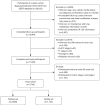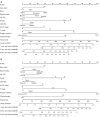Prognostic factor analysis and nomogram construction for elderly patients with stages III and IV epithelial ovarian cancer: a study based on the SEER database
- PMID: 40687249
- PMCID: PMC12268719
- DOI: 10.21037/tcr-24-2129
Prognostic factor analysis and nomogram construction for elderly patients with stages III and IV epithelial ovarian cancer: a study based on the SEER database
Abstract
Background: Epithelial ovarian cancer (EOC), one of the most fatal diseases affecting the elderly women. Advanced stages EOC (stage III and stage IV) presents significant challenges in prognosis and treatment due to factors such as poor treatment tolerance, comorbidities, and immune dysfunction. There is a lack of reliable prognostic tools for elderly EOC patients. This study aimed to develop two nomograms to predict overall survival (OS) and cancer-specific survival (CSS) in elderly patients with advanced-stage EOC using Surveillance, Epidemiology, and End Results (SEER) database, providing a tool for more personalized treatment decisions.
Methods: Data about patients diagnosed with ovarian cancer at stages III and IV from 2010 to 2015 were extracted from the SEER database. Participants were randomly assigned to a training set and a validation set in a 7:3 ratio with OS and CSS as outcome events. Independent prognostic indicators determined in the multivariable analysis were employed in nomograms for predicting 1-, 3-, and 5-year OS and CSS for elderly EOC patients. The predictive performance and clinical utility were assessed using the concordance index (C-index), receiver operating characteristic (ROC) curves, calibration curves, and decision curve analysis (DCA).
Results: The majority of included participants were in stage III (71.38%), while 28.62% were in stage IV. In the OS training set, identified independent prognostic factors included age, race, marital status, tumor grade, T stage, American Joint Committee on Cancer (AJCC) stage, laterality, surgical method, chemotherapy, and cancer antigen 125 (CA-125). In the CSS training set, all these factors were retained except for the variable 'race'. The area under the ROC curve (AUC) for OS in the training set was 0.77 (0.75, 0.80) for 1-year, 0.68 (0.66, 0.70) for 3-year, and 0.66 (0.63, 0.68) for 5-year; in the validation set, the AUCs were 0.74 (0.70, 0.79), 0.69 (0.66, 0.72), and 0.70 (0.67, 0.73), respectively. For CSS in the training set, the AUCs were 0.77 (0.74, 0.79), 0.68 (0.66, 0.70), and 0.67 (0.64, 0.69) for 1, 3, and 5 years; in the validation set, the AUCs were 0.76 (0.71, 0.81), 0.66 (0.63, 0.70), and 0.67 (0.63, 0.70). These results indicate that the developed nomograms possess robust discriminative ability in predicting patients' OS and CSS.
Conclusions: This study establishes clinically relevant nomograms for elderly patients with advanced ovarian cancer, demonstrating significant diagnostic value in predicting OS and CSS.
Keywords: Elderly women; Surveillance, Epidemiology, and End Results database (SEER database); epithelial ovarian cancer (EOC); nomogram; prognostic factors.
Copyright © 2025 AME Publishing Company. All rights reserved.
Conflict of interest statement
Conflicts of Interest: All authors have completed the ICMJE uniform disclosure form (available at https://tcr.amegroups.com/article/view/10.21037/tcr-24-2129/coif). The authors have no conflicts of interest to declare.
Figures







Similar articles
-
Development and validation of nomograms for predicting survival of locally advanced rectosigmoid junction cancer patients: a SEER database analysis.Transl Cancer Res. 2025 May 30;14(5):2808-2821. doi: 10.21037/tcr-24-1810. Epub 2025 May 27. Transl Cancer Res. 2025. PMID: 40530120 Free PMC article.
-
A prognostic nomogram and risk classification system of elderly patients with extraosseous plasmacytoma: a SEER database analysis.J Cancer Res Clin Oncol. 2023 Dec;149(20):17921-17931. doi: 10.1007/s00432-023-05492-6. Epub 2023 Nov 13. J Cancer Res Clin Oncol. 2023. PMID: 37955685 Free PMC article.
-
Dynamic nomogram for predicting the overall survival and cancer-specific survival of patients with gastrointestinal neuroendocrine tumor: a SEER-based retrospective cohort study and external validation.Front Oncol. 2025 Jun 4;15:1594591. doi: 10.3389/fonc.2025.1594591. eCollection 2025. Front Oncol. 2025. PMID: 40535122 Free PMC article.
-
Impact of residual disease as a prognostic factor for survival in women with advanced epithelial ovarian cancer after primary surgery.Cochrane Database Syst Rev. 2022 Sep 26;9(9):CD015048. doi: 10.1002/14651858.CD015048.pub2. Cochrane Database Syst Rev. 2022. PMID: 36161421 Free PMC article.
-
Poly(ADP-ribose) polymerase (PARP) inhibitors for the treatment of ovarian cancer.Cochrane Database Syst Rev. 2022 Feb 16;2(2):CD007929. doi: 10.1002/14651858.CD007929.pub4. Cochrane Database Syst Rev. 2022. PMID: 35170751 Free PMC article.
References
LinkOut - more resources
Full Text Sources
Research Materials
Miscellaneous
